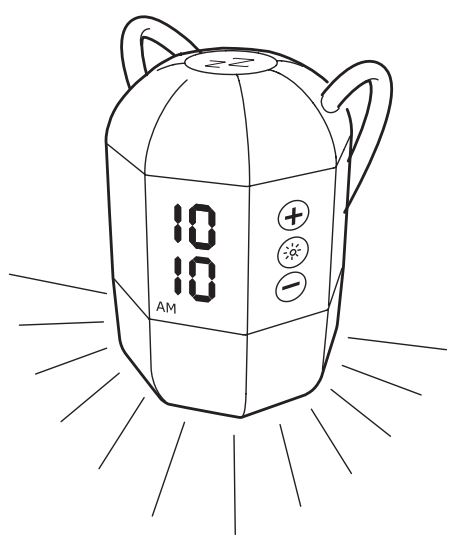
IKEA Alarm Clock wake-up Instructions
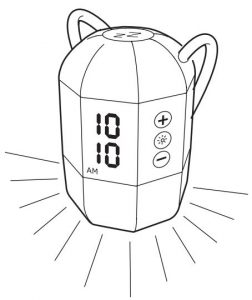
Overview
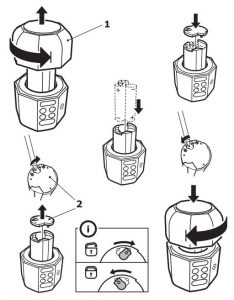
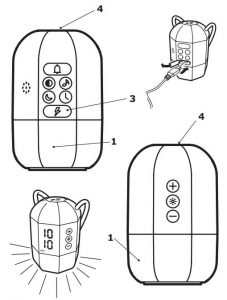
Getting started
Remove light lens (1) and open lid (2) and insert AA Ni-MH batteries with correct polarity and/or connect USB cord into connector (3).
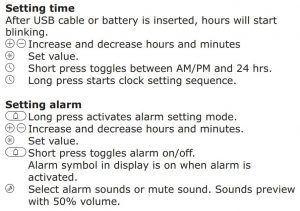


Waking up with alarm20 minutes before the alarm goes off the main light starts from minimum brightness level.
During this 20 minutes cycle the brightness gradually increases until it reaches 100% at the alarm set off time. If the sound is not muted sound starts playing at zero volume at the alarm time and increases slowly during 2 minutes until it reaches 100%.
By tapping (4) on the top of product the alarm will be snoozed. To stop the alarm, press any button.
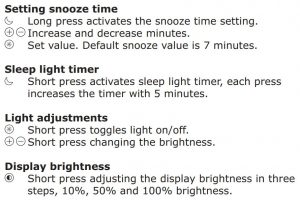
ChargingWhen battery is low the battery symbol will flash. Connect a power supply to the USB-C connector (3). For charging, use only Ni-MH type AA rechargeable batteries. Do not use or attempt to charge other types such as Alkaline, Carbon Zink etc. The wake up lamp has built in protection and will detect wrong battery types. Er will show in display in case of error
Recommended power supply:5V DC, min 2A (Not included)
Recommended battery types:3 x IKEA LADDA 2450 (AA, 1.2V, 2450mAh, Ni-MH) (not included). Use only Ni-MH type batteries.Do not use Alkaline, Carbon Zink etc battery types.Do not mix batteries of different capacities, types or date stamps.Remove batteries if luminary to be stored for a long period or before it is scrapped.Disconnect device from supply before removing batteries and dispose batteries safely
TECHNICAL DATA
- Type nr: E1803
- Input: 5V DC, 1A, 5W or 3xAA
- Max lumen output: 130lm
- IP-Class: IP44
- Operating temperatures: 0°C to 40°C (32°F to 104°F)
Estimated battery run time:
- Max brightness on both light and display: 10h
- 50% brightness on both light and display: 17h
- Min brightness on display and Light off: 7days
Manufacturer: IKEA of Sweden ABAddress: Box 702, SE-343 81 Älmhult, SWEDEN
WARNING:Read all safety warnings and instructions. Failure to follow the warnings and instructions may result in electric shock, fire and/or serious injury.
- Use the lantern only with 1.2V AA Ni-MH rechargeable batteries. Use of any other type of battery may create a risk of injury and fire.
- Do not use a battery or appliance that is damaged or modified.
- Damaged or modified batteries may exhibit unpredictable behavior resulting in fire, explosion or risk of injury.
- In the event of a cell leaking, do not allow the liquid to come in contact with the skin or eyes.
- Follow all charging instructions and do not charge the batteries or lantern outside of the temperature range specified in the instructions. Charging improperly or at temperatures outside of the specified range may damage the battery and increase the risk of fire.
- To reduce the risk of injury, user must read instruction manual
- Only use the charger in dry locations.
- Children should be supervised to ensure they do not play with the product.
- If the charger is damaged it shall be destroyed.
WARNING:
- Never install the product in a confined space. Always leave a space of at least 5 mm around the product for ventilation.
- Product and batteries (battery pack or batteries installed) shall not be exposed to excessive heat such as sunshine, fire or similar. No naked flame sources, such as candlelight should be placed on the apparatus.
- The light source contained in this luminary shall only be replaced by the manufacture or his service agent or similar qualified person. Only to be supplied at SELV.
CAUTION:
- Risk of explosion if batteries are replaced by an incorrect type.
- Dispose of used batteries according to the instruction.
- Do not attempt to repair this product yourself, as opening or removing covers may expose you to dangerous voltage points or other risks.
This device complies with Part 15 of the FCC Rules/ Innovation Science and Economic Development Canada’s licence-exempt RSS standard(s). Operation is subject to the following two conditions:
(1) this device may not cause harmful interference, and(2) this device must accept any interference received, including interference that may cause undesired operation of the device.
WARNING:Any changes or modifications to this unit not expressly approved by the party responsible for compliance could void the user’s authority to operate the equipment.
NOTE:This equipment has been tested and found to comply with the limits for a Class B digital device, pursuant to part 15 of the FCC Rules. These limits are designed to provide reasonable protection against harmful interference in a residential installation.
This equipment generates, uses and can radiate radio frequency energy and, if not installed and used in accordance with the instructions, may cause harmful interference to radio communications. However, there is no guarantee that interference will not occur in a particular installation. If this equipment does cause harmful interference to radio or television reception, which can be determined by turning the equipment off and on, the user is encouraged to try to correct the interference by one or more of the following measures:
- Reorient or relocate the receiving antenna.
- Increase the separation between the equipment and receiver.
- Connect the equipment into an outlet on a circuit different from that to which the receiver is connected.
- Consult the dealer or an experienced radio/TV technician for help.
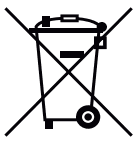 The crossed-out wheeled bin symbol indicates that the item should be disposed of separately from household waste. The item should be handed in for recycling in accordance with local environmental regulations for waste disposal. By separating a marked item from household waste, you will help reduce the volume of waste sent to incinerators or land-fill and minimize any potential negative impact on human health and the environment.
The crossed-out wheeled bin symbol indicates that the item should be disposed of separately from household waste. The item should be handed in for recycling in accordance with local environmental regulations for waste disposal. By separating a marked item from household waste, you will help reduce the volume of waste sent to incinerators or land-fill and minimize any potential negative impact on human health and the environment.
For more information, please contact your IKEA store.
[xyz-ips snippet=”download-snippet”]

